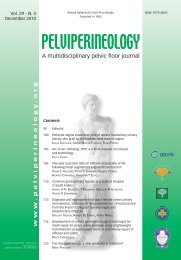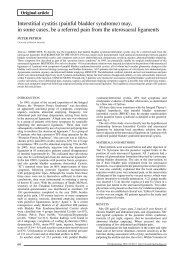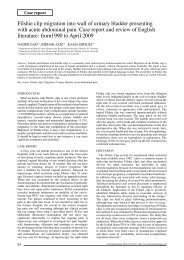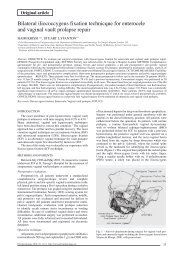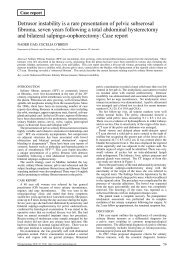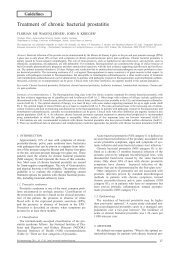This Issue Complete PDF - Pelviperineology
This Issue Complete PDF - Pelviperineology
This Issue Complete PDF - Pelviperineology
Create successful ePaper yourself
Turn your PDF publications into a flip-book with our unique Google optimized e-Paper software.
LATEST NEWS FROM THE <br />
<br />
<br />
, Liege University, Belgium<br />
In the past each specialist of the perineum, the gynecologist, the urologist and the colo-proctologist, has to deal with two main<br />
symptoms: one which reflects a failure to maintain the door closed (incontinence) and one which is linked to a difficulty to open<br />
the way (obstruction). In this old approach the only problem of the specialist is to treat “his incontinence” without creating “his<br />
obstruction” and reverse.<br />
For example, the urologist working only on “his axis” has to treat urinary incontinence without creating dysuria or to treat dysuria<br />
without inducing urinary incontinence. The gynecologist has to treat genital prolapse (vaginal incontinence to solid) without inducing<br />
dyspareunia or to treat dyspareunia without creating prolapse. The coloproctologist is facing the same problem on his “axis”<br />
with anal incontinence and dyschesia. <strong>This</strong> “mono axis” approach has explained many severe iatrogenic dysfunctions unknown<br />
by the surgeons who weren’t aware of the side effects they have created on the other axes. The Burch’s colposuspension is a<br />
very good example of this drama. 1<br />
One of the main issues in Perineology is to obtain a complete history of the patient including the three axes (gynecological, urological<br />
and colo-proctological). Because each of these axes has two ends, one “incontinence” and one “obstruction”, it is possible<br />
to draw a radar diagram including these six main symptoms (dyspareunia, prolapse, dysuria, urinary incontinence, dyschesia,<br />
anal incontinence). We called this diagram “” for “ ”. 2<br />
In its first version each of the six symptoms was evaluated according to a three level ordinal scale: 0 = no problem, 1 = mild<br />
problem, 2 = severe problem. If the patient was completely normal, the shape of the TAPE was hexagonal (Fig. 1). 3-5<br />
<strong>This</strong> version was already interesting because if you have this diagram in your mind it is impossible to treat a patient without<br />
taking care of all her symptoms. The first weakness of this approach was the rough evaluation of the symptoms which has not<br />
been validated and was not recognized by the peers. The second one was the difficulty to draw this diagram and to use it in<br />
the practice. The third one was the lack of evaluation of perineodynia (painful perineum) which can be the main symptom in this<br />
area.<br />
The T.A.P.E. freeware was created to correct all these weakness. It has been realized in collaboration with Mr Fabian Terf and<br />
financed by the sponsors of the Groupement Européen de Périnéologie (GEP).<br />
With this freeware, the TAPE can be draw immediately by just entering the data. You can choose the validated questionnaire<br />
you want for each symptom. If there is no questionnaire available for one symptom, our three levels scale can still be used. By this<br />
way you can obtain quickly a three axes, easily comprehensible and validated evaluation of your patient. A visual analog scale<br />
has been added for the evaluation of pain (Fig. 2).<br />
It is possible to print each evaluation of the patient separately or the<br />
complete file with all the evaluations to follow the effects of the different<br />
treatments during the time.<br />
<br />
Fig. 1. – First version of the TAPE.<br />
Fig. 2. – New version of the TAPE.<br />
<strong>Pelviperineology</strong> 2008; 27: 29-30 http://www.pelviperineology.org<br />
29



